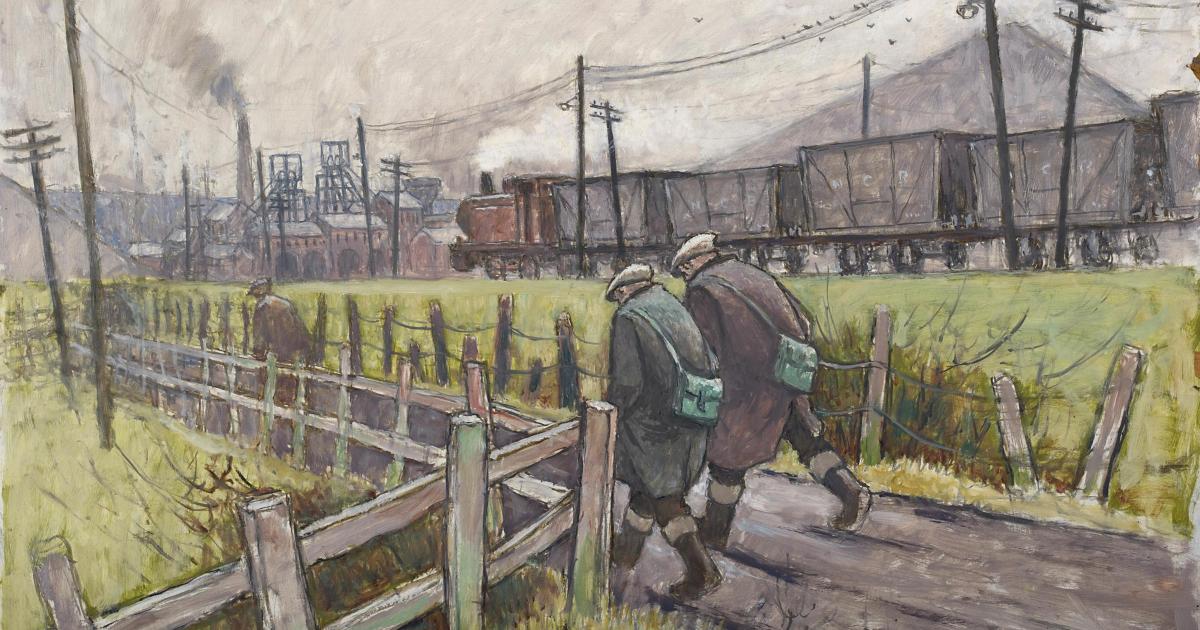They have to. The railways brought the coalfield to life, and as a chronicler of the people of the coalfield, Norman had to include them, but they are often there in the background – just as they were in many mining communities.
For many years the Cornish family lived in Bishops Close Street in Spennymoor, which had the Bishop Auckland & Ferryhill branchline running on an embankment at the end of it with quarry tracks wrapping behind its outside toilets at the rear.
The noise and the rhythm of the railway, and its smuts and its smells, must have been an ever-present backdrop to life in most Durham mining towns and villages, and so they are there as part of the background of Norman’s paintings while everyday life went on around them.
One of our favourite Cornish paintings because you can feel the whoosh of the hot steam and smoke enveloping the people crossing the railway bridge, and you can hear the commotion of the kid booling the hoop, the dogs barking, the pigeons circling, the women nattering and the child pulling their mother to get up close to the engine on the level crossing. And what about the hope of the woman who has hung her white washing out to dry right next to the railway line? Norman called this painting Colliery Memory. In 2008, he said: “When I was courting my wife Sarah – that would be 60 years ago – the bus from Spennymoor used to come round the corner into Trimdon Grange and this is the scene I used to see as I got off.” Once-upon-a-time, when railways were ubiquitous, many towns had their routines punctuated by level crossings which held life up for several minutes every hour. Now Northallerton is the only one brave enough to bring down the gates and tell motorists they have to wait”You don’t get this today,” he told The Northern Echo in 2008, referring to the painting above, “this mixed up jumble of streets and washing and collieries and railways all in a great big heap together.”
As a contribution to the celebrations of the 200th anniversary of the Stockton & Darlington Railway, Norman’s son-in-law, Mike Thornton, has compiled some of Norman’s images which feature railways for his weekly blog on the artist’s official website.
READ MORE: RELIVING THE 1975 RAILWAY CAVALCADE WITH A TIN OF GENUINE LOCOMOTIVE STEAM
“The only time Norman would travel by train was when he gave a few talks over in Carlisle and then when he was going down to London in the 1950s and 1960s where he had exhibitions,” says Mike. Norman regularly went up to Newcastle on the bus.
Although Norman cannot be considered a railway artist, they are there in the mix of the lives of the people that he was capturing.
He once said: “The railways, which are fast disappearing, as such are a compelling source of pictorial art in terms of human history or any other terms for that matter.”
To learn more about Norman Cornish, and to see Mike’s blog, visit normancornish.com
Norman Cornish often travelled by bus to Newcastle to go to the Stone Gallery, which exhibited and sold his paintings. It was the gallery which introduced him to the Manchester painter, LS Lowry, who became his friend.
He was also friendly with Sid Chaplain, the writer who, like him, had worked in the Dean and Chapter Colliery at Ferryhill. They would occasionally meet up to discuss their similar artistic subjects and one day they went for a walk through the Byker area which in the early 1960s, Sid featured in two of his novels, The Day of the Sardine, and The Watchers and the Watched.
It was on this trip that Norman sketched Byker Bridge on a double page across his sketchbook – it must have been quite a physical feat holding the book open and steady with one hand and sketching so smoothly with the other with his favourite Flo-master pen.
But no! It was not right.
“I remember showing Norman Byker Bridge,” said Sid. “He made a drawing, then shook his head. ‘It’s all Lowry.’ The drawing was sterile – not because it was Lowry’s subject – but because it straddled another world, and to re-create the bridge he must know the people who use it or live around it.”
The sketch was discarded and only re-discovered in 2012 by his family.
Which is a bit of a shame because there is some real movement among the great shapes of the industry of Tyneside – but it was not Norman’s industry, and so he didn’t work it up into a completed painting.
Norman Cornish regularly returned to the Pit Road scene, of the miners trudging into work. In this version, the train in the background, facing the same way as they are, seems to have similar feelings at the prospect of another day’s hard labour in front of it
The Merrington Lane signal box behind the Cornishs’ home in Bishops Close Street in Spennymoor. “As the collieries closed in the early 1960s, the lines and buildings became redundant but simultaneously they became an adventure playground for children with structures to climb and crawl all over,” says Mike Thornton, and here Norman captures their glee
A railway waggon sketched by Norman Cornish
A sketch of a railway locomotive, by Norman Cornish
The signal box at Trimdon Grange. No people, but what a complex assortment of shapes and planks and wires and poles and colliery winding gear
The famous Durham railway viaduct, as seen by Norman Cornish
Life on a snowy day in Bishops Close Street by Norman Cornish. Everyone is playing in the snow, having a whale of a time, but in the distance, the railway rolls on…READ MORE: INSIDE STORY OF THE DURHAM MANSION THAT IS NOW ON THE MARKET FOR NEARLY £3m

